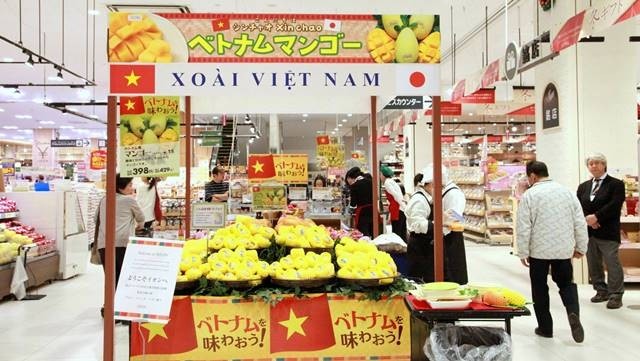With the agricultural export revenue in 2018 reaching a record high of US$40.2 billion USD, Vietnam once again affirmed its position as a powerhouse in agricultural exports. Notably, the result was achieved in the context of a changing world market, with multi-dimensional impacts from the US-China trade tensions. Not only difficulties in price and demand, Vietnam’s major export markets increasingly set strict technical standards for imported agricultural products.
However, in the context of volatile world trade, 2018 also witnessed a change in the thinking of domestic agricultural regulatory agencies, which is the agricultural sector has prioritised the opening of new international markets. Negotiations with foreign countries for boosting consumption for Vietnamese agricultural products are being held more regularly. Particularly in 2018, the Ministry of Agriculture and Rural Development (MARD) sent six working missions to China to discuss opening doors for Vietnamese commodities.
Thanks to such efforts, many Vietnamese agricultural products have set foot in new markets, such as beef and milk in Malaysia, pork, chicken and eggs in Singapore and pork, milk, seafood and rice in China. This year, for the first time, other Vietnamese agricultural products have been granted new "visas", such as chicken meat to Japan, frozen pork to Myanmar, star apple fruit to the US, rambutan to New Zealand and passion fruit to the EU. Although the export volume of such products remains limited, it has shown the prestige of Vietnamese agricultural products which have been recognised worldwide.
It is clear that new opportunities for Vietnamese agricultural exports are opening up. However, in 2019, as the Comprehensive and Progressive Agreement for Trans-Pacific Partnership (CPTPP) comes into effect, both opportunities and challenges await Vietnamese agricultural products.
The development of sustainable and highly competitive agricultural value chains is becoming an urgent task. However, in order to ensure the competitiveness of export agricultural value chains and quality and food safety, the agricultural sector should firstly develop standards that meet the requirements from import markets.
In order to comply with the standards, manufacturers need to meet Good Agricultural Practices (GAP), Hazard Analysis and Critical Control Points (HACCP) and Good Manufacturing Practices (GMP), as well as getting certifications for plantation area codes. For example, China - the largest market for Vietnamese fruits - requires production areas to be certified with planting area codes to be eligible for exports via formal channels. It is difficult for Vietnam because production areas must quickly change their method of managing production to ensure food safety.
It can be said that the development of national standards for agricultural products is the minimum standard for all types of production that must achieve the objective of meeting the food safety needs in import markets, while not negatively affecting Vietnamese specialty products. Another factor related to the standards is the professionalism and the ability of international integration of both national and private quality certification systems (such as GAP or organic standards) in Vietnam remain low, which needs to be developed in a short time to reduce certification costs and increase credibility and trust.
.jpg) |
Vietnam’s exports of agro-forestry and aquatic products in 2018 (compared to 2017) (Graphics: NDO/Trung Hung)
Currently, Vietnam has signed trade agreements with six markets, including the US, EU, China, Japan, the Republic of Korea and ASEAN, with preferential tariff reductions. However, in order for products to be able to be circulated, the State's negotiation capacity and the ability to improve product quality and food safety by producers and businesses to overcome technical barriers are important. This poses extremely urgent requirements for State management agencies and enterprises when participating in producing, processing and exporting agricultural products.
On the other hand, the need for synchronous investment and modernisation of agricultural value chains is extremely urgent. In particular, the State needs to develop a strategy to attract investment in cold chain value development because Vietnamese agricultural products are mainly exported in fresh forms.
At present, the rate of cold storage application for aquatic products is the highest, reaching 95%. However, the figure for fruit and vegetables is only at over 6%. Clearly, a lack of professional preservation and warehousing services forces export companies to have to invest by themselves, pushing up costs for logistics. Some foreign companies have invested in this area but are short of information connection with production areas. Therefore, closer cooperation between chain service providers and producers should be promoted.
In addition, the promotion of processed agricultural products for export in order to diversify products, such as fruit juice or dried fruits and vegetables, is a necessary step to reduce market risks. The demand for cooperation between processing enterprises with production areas and research institutes is a positive model that should to be widely disseminated, as the model of Nafoods Group with the Vietnam Academy of Agricultural Sciences and cooperatives in farming and processing passion fruits.
Value chain actors need to promote close cooperation under the cooperative-enterprise model for quality management, through step by step applying e-traceability, such as applying blockchain technology to create transparency in information for fastidious markets, combined with e-commerce, access to modern distribution channels and proactively reducing exports via informal channels. Blockchain traceability has been first applied to mangoes of My Xuong Mango Cooperative in Dong Thap province, helping the product that has become famous in the domestic market to set foot in the Japanese and American markets.
One indispensable aspect is that the MARD needs to pay special attention to improving the quality of market research and forecasting, especially in key markets such as the US, Europe, Japan and China, thus promptly providing alerts related to regulations on barriers and problems that may arise for exports, while organising trade promotion activities to introduce Vietnamese agro-forestry and fishery products in foreign markets.
If there is a strong innovation in management and administration, Vietnam’s second rank in Southeast Asia and 13th in the world regarding agricultural exports, may be further improved.
















